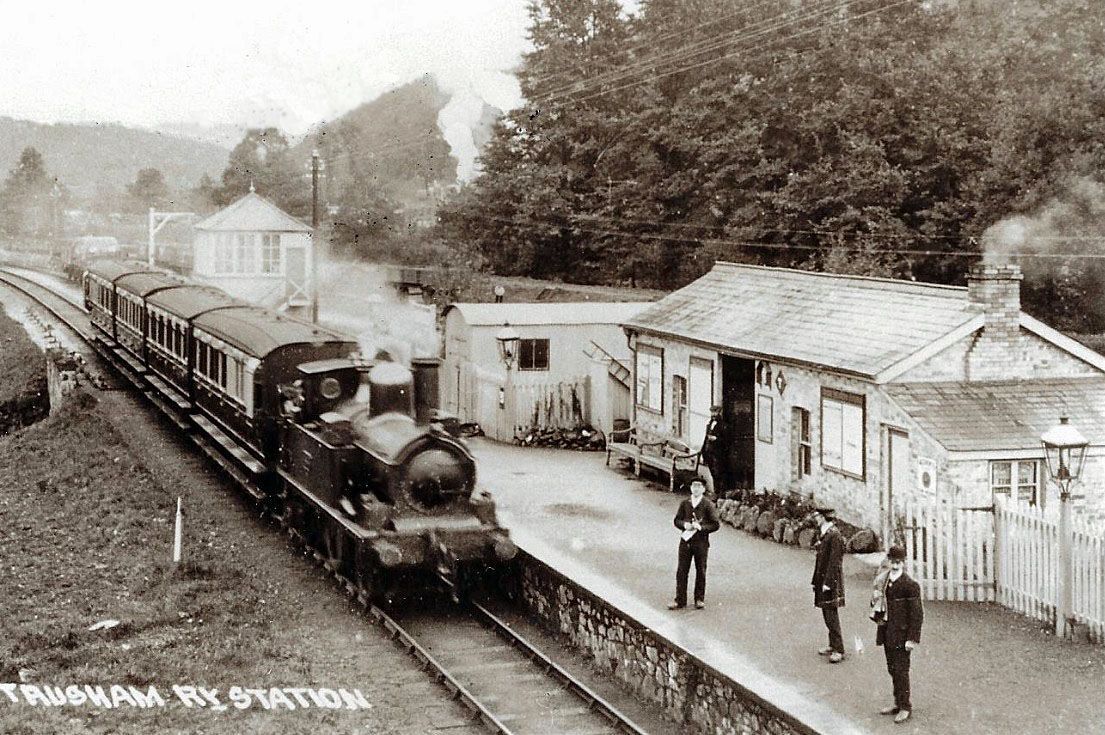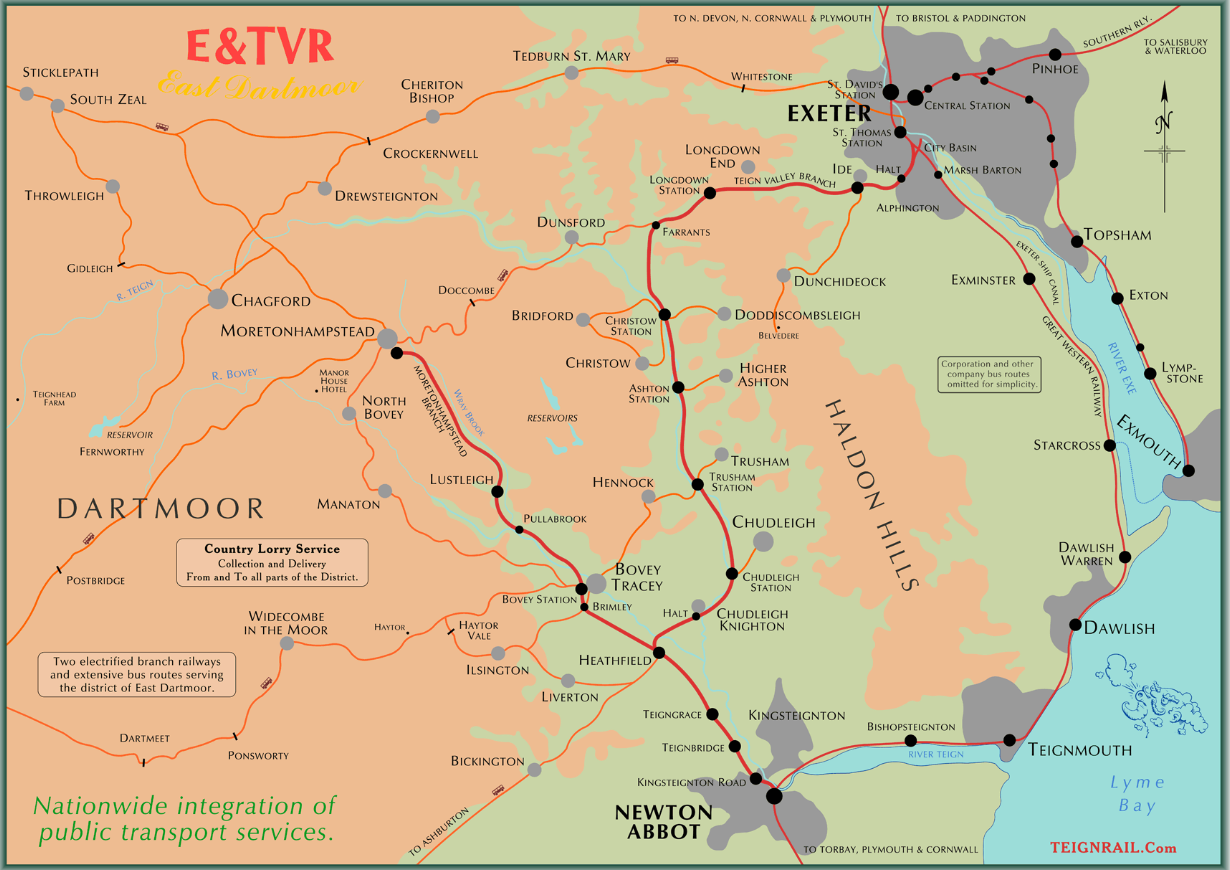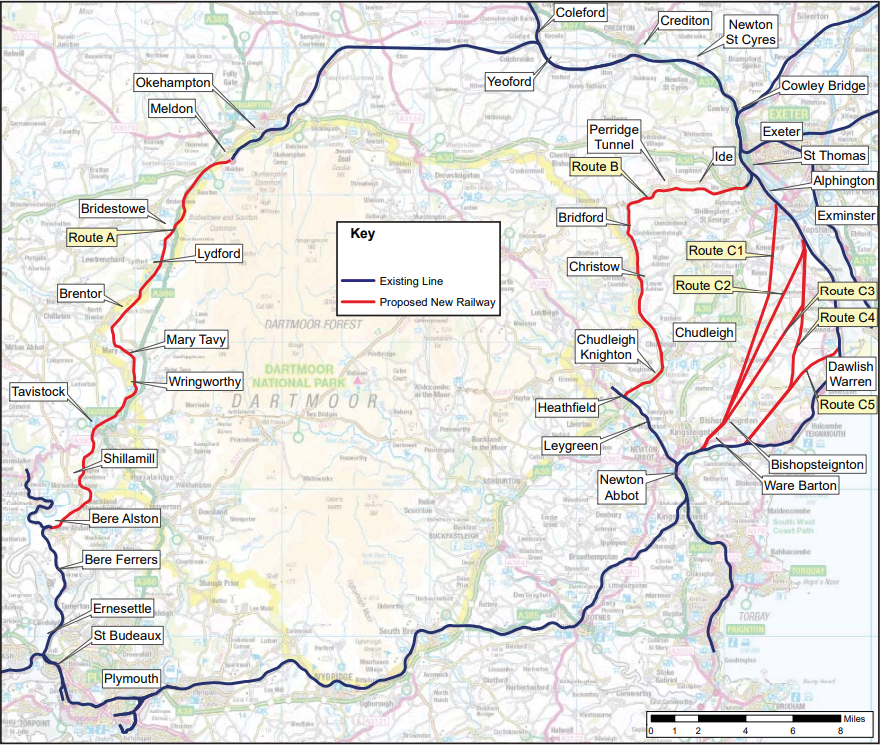Railways

Teign Valley Line, Trusham Railway Station, 1905
A case for re-opening the Teign Valley Line
Executive Summary
The Teign Valley Railway Line connected Exeter to Newton Abbot, via a scenic inland route on the edge of Dartmoor. It closed in 1967. There have been repeated proposals to re-open the line, partly because of the frequent disruption by storms of the Dawlish coastal section of the only mainline from Exeter to Plymouth and Cornwall. The re-opened Teign Valley route would allow trains from London to Plymouth and Cornwall to continue in the event of disruption around Dawlish. Rail links would be restored in a popular tourist area, with the possibility of reconnecting Bovey Tracey and Moretonhampstead with the national railway network. In addition, the restored Teign Valley Line could play a major role in helping to reduce road traffic congestion on the southern approaches to Exeter. The South-West Region has the lowest per capita public spending on railways in England. The time has come for this region to get a fair deal, serving its tourist industry and its permanent population.
In 2014, Colin Burges made a case for reopening the Teign Valley Line
A printable copy of this present study (with fuller references) is available HERE.
1. The Teign Valley Line and the Dawlish problem
Opening in 1882, the Teign Valley Line ran originally from Heathfield (near Bovey Heath) – on the railway from Bovey Tracey to Newton Abbot – to Christow Station in the Teign Valley. In 1903 it was extended north and west to the mainline near Exeter. This involved two tunnels near Longdown, passing through Ide and Alphington, eventually joining the mainline at Exeter City Basin Junction. As well as providing a passenger service from Exeter to Newton Abbot on an inland route, the line also severed several mines in the Teign Valley. But mining declined and had ended by 1969. Passenger services ended in 1958 and the line was closed to all traffic in 1967.
The line is of potential importance for the whole railway network in the Southwest, as well as for the Teign Valley and the Bovey Valley. The only surviving railway, linking Plymouth and the whole of Cornwall with the national rail network east of Exeter, passes along the coast at Dawlish. This Dawlish section, which follows the sea wall, is highly vulnerable to storms.

Map 1: Existing and Former Railways between Exeter and Dartmoor
Reproduced with kind permission of teignrail.co.uk
After a severe storm, on 6 January 1930 the Western Morning News carried the headline ‘Track Hanging Over Chasm, 40-ft Breach in Sea Wall at Dawlish, Traffic Diverted to Teign Valley’. Notwithstanding the economic rigours of the Great Depression, in 1933 it was proposed to build a Dawlish Avoiding Line. Near Exminster, the mainline would be moved inland, circumventing the Dawlish and Teignmouth sections along the coast. It would involve three tunnels under the Haldon Hills – one of which would be 2.4km in length – and rejoin the existing main line near Bishopsteignton. Some modified proposals followed. Construction started in Spring 1939, but all work stopped at the outbreak of the Second World War. It was never restarted.
Calls for the revival of the Dawlish Avoiding Line were revived after storms closed the Dawlish sea wall route in 2012 and 2013. Severe storms in February 2014 demolished a 150-metre section of the mainline. The railway was closed for two months for major repairs. One estimate put the economic cost of the closure, including to tourism and fishing in Devon and Cornwall, at up to £1.2 billion.
Subsequent work on rebuilding the line, strengthening the protective sea wall, and providing rockfall protection in the Dawlish area cost over £165 million from 2014-2023. But despite costly investments in the sea defences, storms have still interrupted rail services along the line. Take the winter of 2023-24 alone. In October-November 2023, Storm Ciarán dislodged 20 large slabs on the Dawlish sea wall, adjacent to the railway line. In early February 2024, huge waves crashed over the top of the sea wall, requiring about 50 people to be evacuated from their homes on the other side of the coastal railway. Train services were again interrupted.
Further expenditures are planned to try to alleviate the Dawlish problem. As things stand, rail connections to South Devon, Plymouth, and the whole of Cornwall, involving over a million permanent residents and additional millions of annual visitors, are vulnerable to storms affecting the sea wall stretch of railway around Dawlish. According to a recent study, with global warming and rising sea levels, storm threats to the Dawlish line are likely to get worse.
If the Dawlish Avoiding Line were not built, then two further options for avoiding the Dawlish section might be considered. One would be to extend the recently revived railway from Exeter to Okehampton further southwards through Tavistock to Plymouth. This would follow the route of the former London and South-Western Railway. This option is currently under consideration.
The re-opened Exeter-Okehampton-Tavistock-Plymouth route would involve a detour of 88 km off the mainline from Exeter to Plymouth. The spectacular Meldon Viaduct would require rebuilding. This route involves a long diversion from the existing mainline.
Re-opened in 2021, the line from Exeter to Meldon (near Okehampton) involved 39 km of re-laid track. From Bere Alston, there is an existing 12 km railway, southwards to the main line near Plymouth. The extension from Meldon through Tavistock to Bere Alston would involve 37 km of new track.
Another option is to re-open the Teign Valley Line. The UK government considered reopening the railway after the severance of the mainline track by coastal storms at Dawlish in February 2014. The Campaign for Better Transport released a report in January 2019 which described the line as their ‘Priority 2’ for reopening. The journey would be a kilometre longer than the existing mainline route, but national rail communications to South Devon, Plymouth and Cornwall would all be maintained in the event of a closure around Dawlish.
The re-opened Teign Valley rail route would involve a single-track detour of 30 km off the mainline from Exeter to Newton Abbot. It would involve only 22 km of new track, compared with 37 km on the Okehampton-Tavistock-Plymouth route.
There are strong cases for re-opening both the Okehampton-Tavistock-Plymouth line and the Teign Valley Line. The former has strong tourist potential, as it skirts the north and west of the Dartmoor National Park. It also would restore Tavistock’s links to the railway system.
The Teign Valley Line skirts the eastern flank of Dartmoor. It too has tourist potential and would serve the communities along the Teign Valley. It may be the best single option to address the Dawlish problem. Consider the marginal costs and benefits of each option, in relation to the Dawlish issue. In the event of a Dawlish interruption, the marginal benefits of the Teign Valley option, over the line through Tavistock, would be:
(a) to maintain railway links with a populous area of South Devon, including Newton Abbot and the large Torbay conurbation, and
(b) to extend the journey distance from Exeter to Plymouth by only about one kilometre, possibly adding only a few minutes to the journey, compared with the much longer deviation via Okehampton and Tavistock.
Concerning costs, both projects require substantial investment. The Okehampton-Tavistock-Plymouth requires more newly laid track and the replacement of the Meldon Viaduct. The Teign Valley option requires substantial investment, especially for the short section between Alphington and Ide, close to Exeter. As Colin Burges put it in his case for re-opening the Teign Valley Line: The costliest works would be ‘at Alphington, relining Perridge Tunnel and building a new alignment alongside the A38 between Chudleigh and Chudleigh Knighton, for which the path is clear.’
Because of its curves and gradients, the reopened Teign Valley Line would not allow for high speeds. But if they had to divert to the line because of a main line closure at Dawlish, then its relatively short distance would not delay mainline trains greatly. In addition, the line would provide enhanced transport links in a rural area and help to relieve congestion in the urban area around Alphington near Exeter.
A 2014 study by Network Rail costed the following different options as follows :
1. Reconstructing the former London and South-Western Railway route from Exeter to Plymouth via Okehampton. Estimated cost £875 million. In 2014 the Exeter-Okehampton stretch was intact and run by a private company.
2. Constructing a modern doubletrack railway on the alignment of the former Teign Valley Line from Exeter to Newton Abbot. The estimated cost was £470 million. The practical viability of a double track railway was questioned. A double track railway is not proposed here, so the cost would be considerably less.
3. A new Dawlish Avoidance line. Five alternative direct routes on a new line between Exeter and Newton Abbot had an estimated cost between £1.49 billion and £3.10 billion.
Of course, these estimates need to be adjusted in the light of inflation and additional information. The first and second options are much cheaper than the third. The first and second options should be seen as complements rather than rivals. In which case, both lines could offer relief in the event of a main line closure around Dawlish.

Map 2: Network Rail’s Costed Options
(2014)
2. Restoring the Teign Valley Railway
A revived rail route from Exeter to the Teign Valley would have to find a way around new building and road development, near to the Sainsbury’s supermarket in Alphington and around the nearby roundabout serving the A30. One option might be to extend the existing rail spur from grid reference SX 917907 to the Alphin Brook and west to Ide. (See Section 3 below and https://www.teignrail.co.uk/whats-new.php#itcant). The 3.5 km of the route further westwards from Ide is relatively clear of obstruction.
Moving west the next problem is the Perridge Tunnel (0.76 km) near Longdown, which apparently has suffered some internal collapse. A rail link would depend on the repair and reopening of the Perridge Tunnel. Just to the west, the shorter Culver Tunnel (0.28 km) is reportedly still intact.
Moving west from the Longdown tunnels, the line turns south beside the B 3193 road and the Sowton Brook, and then follows a long embankment on the east side of the Teign Valley. At several places the line is crossed by tracks leading to dwellings. These include Horrowmore (SX 844896), Kingscourt (SX 836889), and Kolora Park (SX 836885). In at least one case the track used to pass under the railway line but the bridge over the track has been removed. In other cases (e.g. Leigh Cross SX 835874) the bridge remains.
The old station at Christow (SX 840864) is a residential building. The trackway between the platforms has been infilled to the platform level. The railway followed the east bank of the River Teign, until it crossed and re-crossed it at SX 842853 and SX 842848. The two bridges at these points would have to be restored or rebuilt, or the line could be diverted to keep to the east side of the river.
Moving further south, the next stretch passes Lower Ashton, keeping on the east side of the river until Crockham Bridge (SX 852808). It returns to the east side at Huxbear Bridge SX 856796). About 500 metres south of that bridge, the old line is built over by a 3 km stretch of the A38 dual carriageway. The railway could be rebuilt just aside the A38 to Chudleigh Knighton. Skirting to the south of the Chudleigh Knighton Clay Works, the railway would rejoin its old route at SX 840768 and then a further kilometre southwest to reach the still-intact rail link at Heathfield.
Bovey Tracey is only 3 km north-west of Heathfield, along another disused branch of railway. Re-opening the Teign Valley Line creates an opportunity of re-linking Bovey Tracey and Moretonhampstead to the national rail network via this branchline. The line from Heathfield to Newton Abbot is apparently in need of restoration but it can still be used by goods traffic.
3. The Alphington-Ide Link and Congestion in Exeter
As noted above, restoration of the Teign Valley Railway would require substantial investment in the stretch from Alphington to Ide. This section discusses some of issues involved in this expanding area to the south of Exeter city centre.
As shown in Map 3 below, the A30 dual carriageway built over a section of the former Teign Valley Line between Alphington and Ide. This can be averted by building a new track deviation for about one kilometre, on a more direct route (marked in orange on the map) over the Alphin Book and the A30. This ‘orange’ link would avoid or just clip the proposed large new housing development at Markhams Farm.
Leaving the question of the desirability or otherwise of the Markhams Farm development on one side, the housing proposal illuminates and would worsen existing problems with the A30 roundabout at Alphington, and especially with the severe traffic congestion regularly experienced from the A377 turnoff and along the Alphington Road towards Exeter. Even before a large new housing development in the area, this section of road is frequently jammed. The traffic congestion typically extends to and engulfs the Exe Bridges Roundabout near Exeter City Centre (near Exeter St Thomas Station at the top of Map 3). The economic and environmental costs of congestion on this scale are massive.

Map 3: Restoring the Teign Valley Railway between Alphington and Ide
The Markhams Farm development would considerably exacerbate this problem, by bringing a great deal more traffic onto the A30 roundabout, much of it bound for Exeter. It would be irresponsible to approve the Markhams Farm development without putting substantial measures in place to deal with this traffic congestion. This current problem of excess road traffic through a dense urban area needs to be addressed, even if the Markhams Farm development does not go ahead. Much of Alphington Road has one lane in each direction. Widening that road would involve the demolition of many homes, in a relatively dense urban area. The Exe Bridges Roundabout would have to be reconstructed, involving the widening of its two bridges.

Figure 1: Sketch Profile of the New Link between Ide and Alphington
The rebuilt Teign Valley Line offers a partial solution. Residents of Ide, Alphington, and elsewhere would be able to access Exeter City Centre by rail. In addition, the shopping areas in Alphington itself – including Sainsbury’s supermarket – could receive passengers from anywhere along the line, with the potential to cut numerous car journeys. The Teign Valley Line could be of substantial help in reducing congestion in this area.
A preliminary survey of the area suggests that it will be possible to build the railway to link Ide with the end of the existing track in Alphington (SX 917907). From Alphington going westwards, the new track would be built on pillars at an upwards incline of about 2 per cent. It would rise above the road complex just to the east of Sainsbury’s supermarket (SX 916906). It would then flank the Sainsbury’s petrol station on its east side, along a section of railway track embankment that still survives. Then it would turn southwest and traverse the A377 (at SX 914905), with sufficient clearance for vehicles below, and head toward the Alphin Brook. In this area the pillars supporting the track would be up to 18 metres above ground level, giving sufficient height clearance to cross the A30 and the road parallel to it on its south side. About 300 metres further southwest (at SX 904904) it would rejoin the former course of the railway on the hillside near Ide.
4. Conclusion
As shown in Figure 2 below, the South-West Region received the lowest level of public expenditure on railways in England in the 2011-17 period. Expenditures in London per capita in those years were almost ten times greater than in the South-West. The region has a strong tourist industry, but it roads are congested. More railways are needed, and the network needs to be more resilient to storms and other shocks.
There is recent evidence that investment in railways, including the opening of closed tracks, can have strong positive effects. In the two years since its re-opening in November 2021 the 39-kilometre Exeter to Okehampton line logged more than 550,000 passenger journeys, far exceeding expectations. This is a tremendous result, for a relatively remote line serving the towns of Crediton, Okehampton and a few other villages. The re-opened Teign Valley Line would serve the several villages along the valley, plus Ide and Longdown, and provide a backup in the event of another closure of the mainline around Dawlish.
In addition, the restored Teign Valley Line could play a major role in helping to reduce road traffic congestion in Exeter, as discussed in the section 3 above. It requires only 22 kilometres of new track.

Figure 2: Regional Disparities in Public Expenditure on Railways
It is recommended that full costings are explored for the full restoration of the Teign Valley railway from Alphington to Heathfield. This would provide vital relief for the London to Cornwall mainline in the event of a closure around Dawlish. It would be of crucial economic benefit for both Devon and Cornwall.
On current evidence and costings, it not necessary to insist that the main line should be rerouted from Dawlish Warren to Teignmouth. But despite extensive investment, there are still risks of closure along this section due to storms. The proposal here is to build in more resilience into the Devon railway network by re-opening both the Teign Valley and Okehampton to Plymouth lines. There are substantial additional benefits in improving rural public transport and helping to reduce road traffic congestion on the south side of Exeter.
Geoffrey M. Hodgson, 14 February 2024
